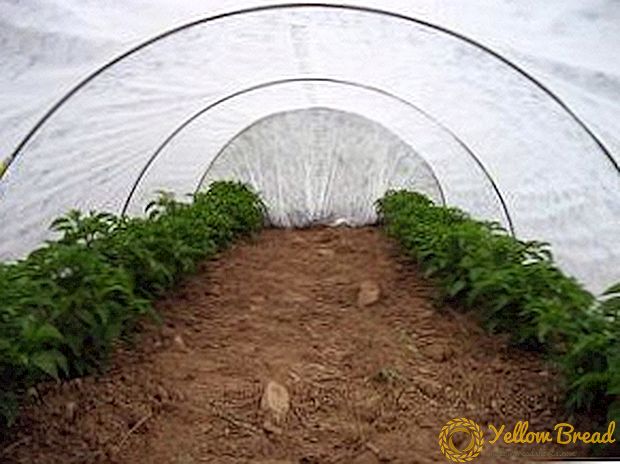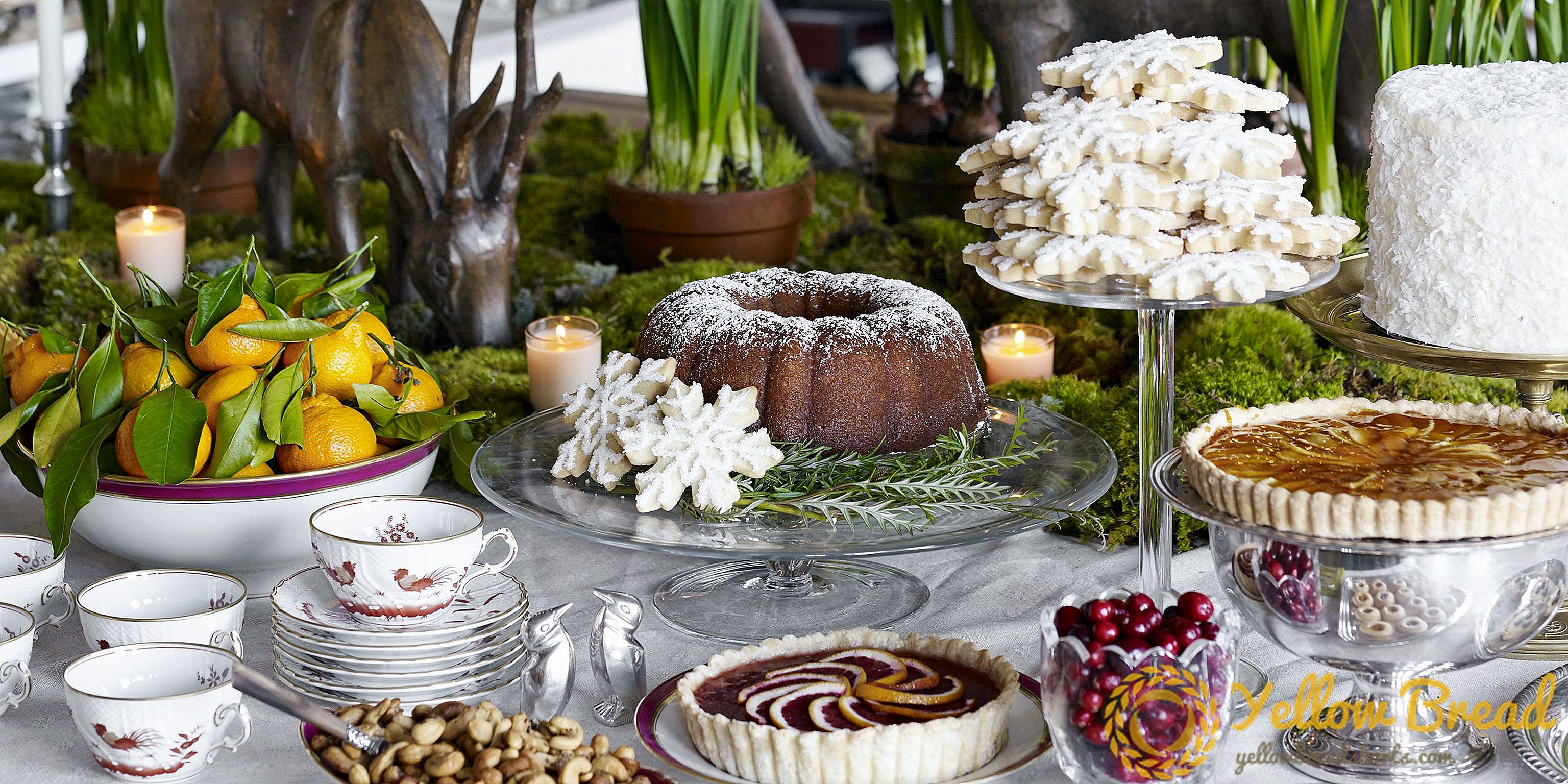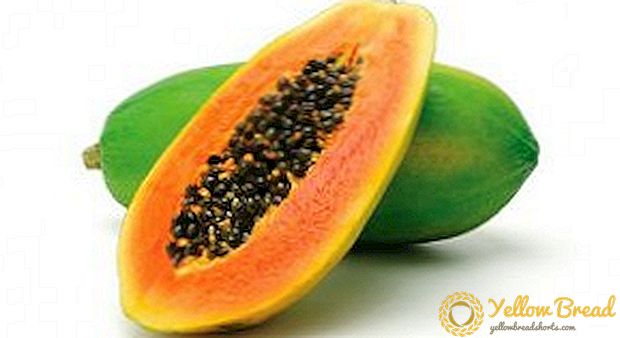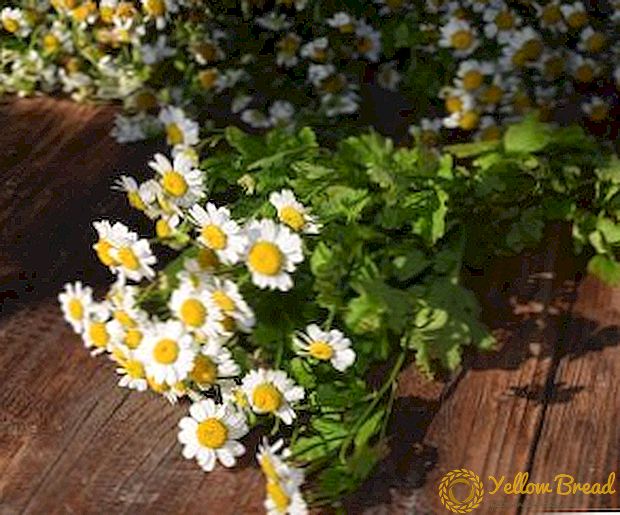 Pyrethrum, also known as Dalmatian chamomile, - This is a perennial garden flower. Pyrethrum is often called chamomile, most likely because this plant has the same “flower design” as a chamomile: a yellow center and numerous petals around the circumference. In fact, the familial relationship of pyrethrum and chamomile is very conditional. There are many species of this plant, differing in shape, color, chemical composition and conditions of growth.
Pyrethrum, also known as Dalmatian chamomile, - This is a perennial garden flower. Pyrethrum is often called chamomile, most likely because this plant has the same “flower design” as a chamomile: a yellow center and numerous petals around the circumference. In fact, the familial relationship of pyrethrum and chamomile is very conditional. There are many species of this plant, differing in shape, color, chemical composition and conditions of growth.
- The choice of location and soil for planting pyrethrum
- Growing pyrethrum from seeds
- Pyrethrum cuttings
- Division of overgrown pyrethrum bushes
- How to care for feverfew
- Watering and mulching the soil
- Top dressing feverfew
- Pruning
- Partners, use in landscape design
- Diseases and pests, how to deal with them
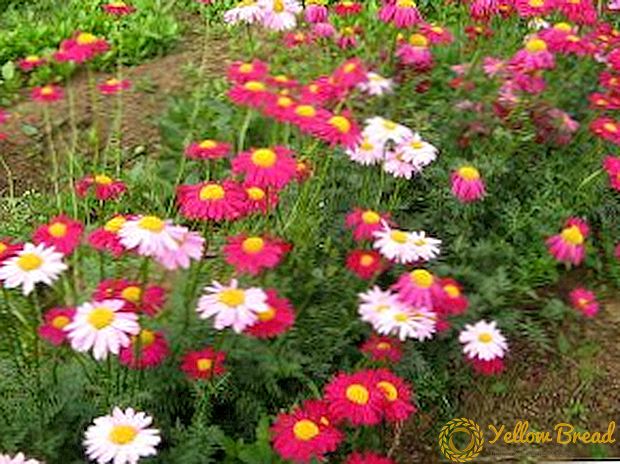 The use of pyrethrum for decorative purposes is not limited. So, some plant species are widely used in medicine, they are used to treat scabies, used as a basis for anthelmintic drugs, and also include in dosage forms to reduce the symptoms of headaches and periodic female pain.In combination with other drugs, pyrethrum is used to treat hypertension, arthritis and rheumatic disease. The effect of feverfew in the treatment of certain mental disorders.
The use of pyrethrum for decorative purposes is not limited. So, some plant species are widely used in medicine, they are used to treat scabies, used as a basis for anthelmintic drugs, and also include in dosage forms to reduce the symptoms of headaches and periodic female pain.In combination with other drugs, pyrethrum is used to treat hypertension, arthritis and rheumatic disease. The effect of feverfew in the treatment of certain mental disorders.
The homeland of pyrethrum are quite warm climatic zones (Caucasus, Central Asia, Mediterranean region), which must be taken into account, wishing to grow Dalmatian chamomile in a more severe climate. At one place pyrethrum can grow more than eight years, but the plant provides the best flowering from the third to the sixth year of life.
The choice of location and soil for planting pyrethrum
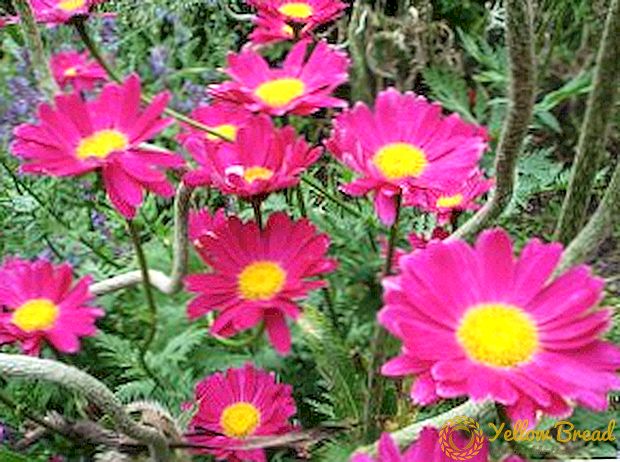 It is best to plant Dalmatian chamomile on a flat sunny plot. A place for pyrethrum should be open enough and not blown by sharp winds, unusual for this plant. The partial shade for Dalmatian chamomile is also quite suitable, but if the sun is too small, feverfew will begin to stretch heavily in height, which will somewhat damage the ornamental look of the shrub.Potatoes, as well as early ripening legumes, are considered good precursors for Dalmatian chamomile.
It is best to plant Dalmatian chamomile on a flat sunny plot. A place for pyrethrum should be open enough and not blown by sharp winds, unusual for this plant. The partial shade for Dalmatian chamomile is also quite suitable, but if the sun is too small, feverfew will begin to stretch heavily in height, which will somewhat damage the ornamental look of the shrub.Potatoes, as well as early ripening legumes, are considered good precursors for Dalmatian chamomile.
Pyrethrum is very unpretentious to external conditions, in particular, to the composition of the soil. It is only important that the plant is provided with good drainage, because pyrethrum does not like water that is stagnant in the root system of water. Thus, you need to make sure that the groundwater is deep enough, and if this is not the case, ensure that artificial discharge of excess water occurs at the site of the pyrethrum.
To ensure long and abundant flowering, it is better to plant feverfew in moderately fertile loose black soil. Also suitable light loam and sandy loam. In any case, the soil should be sufficiently dry and fresh with a neutral or alkaline reaction. It grows poorly and feverfews winters even worse on heavy, marshy or overmoistened soils. Sour, sandy, and too poor soil Dalmatian chamomile is not suitable.
Despite the pronounced heat-loving, feverfew has a relatively good frost resistance: if the temperature does not fall below five degrees of frost, Dalmatian chamomile will easily survive the winter without any additional preparation.
Growing pyrethrum from seeds
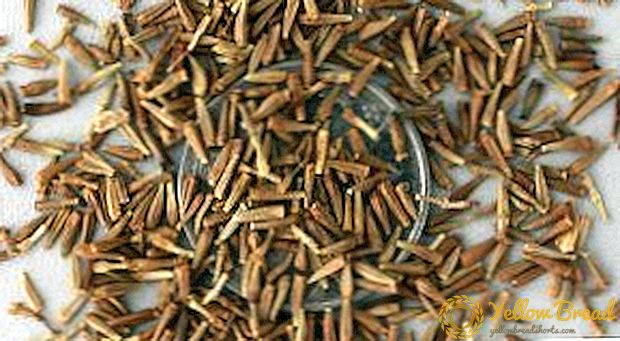 Pyrethrum reproduces in different ways: growing from seed, grafting, dividing the bush, layering. Propagation of feverfew with seeds is possible in two main ways - sowing in open ground and pre-planting on seedlings. In open ground, pyrethrum seeds are sown in early spring, as soon as frosts recede. For better germination, it is necessary to pre-soak the seed for several hours in water at room temperature. Seeding of seeds into the ground should be made quite deep - by 2-3 cm.
Pyrethrum reproduces in different ways: growing from seed, grafting, dividing the bush, layering. Propagation of feverfew with seeds is possible in two main ways - sowing in open ground and pre-planting on seedlings. In open ground, pyrethrum seeds are sown in early spring, as soon as frosts recede. For better germination, it is necessary to pre-soak the seed for several hours in water at room temperature. Seeding of seeds into the ground should be made quite deep - by 2-3 cm.
Some gardeners recommend later sowing, waiting for the soil to warm up completely. If feverfew is planted in May, the seeds can be embedded only 5-10 mm. Shoots in this case appear fairly quickly - just a couple of weeks after disembarkation.
Dalmatian chamomile seeds do not differ by good germinationtherefore, they can be sown quite tightly: after the emergence of seedlings, they will still need to be thinned out (the distance between individual plants should be at least 10 cm). Young growth of pyrethrum is very easy to take root, so that the process of stopping can be carried out without fear.
The autumn method of sowing seeds of pyrethrum is also used. It is believed that germination in this case is provided much better. Sowing is done to a shallow depth, but after that the bed is covered with a layer of humus not less than 1 cm thick. In order not to plant pyrethrum in open ground in early spring, when the ground is too cold, you can plant the plant in pots and boxes for seedlings. In this case, in May, already grown up daisies are planted in a flower garden.
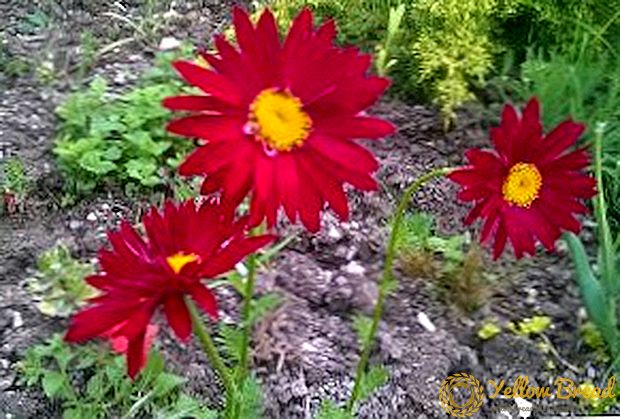 You can start the process in March or in April, depending on the climate. Before sowing feverfew on seedlings, seed preparation is carried out in the same way as when it is planted in open ground. Then they are distributed evenly, but not too densely, on the surface of containers filled with nutrient substrate (the soil must first be thoroughly moistened) and sprinkled on top with a layer of soil of 2-3 cm. Then the containers are placed on a well-lit, but not too warm place. After the emergence of shoots, if necessary, they need to thin out, planting sprouts in separate peat, paper or plastic cups.
You can start the process in March or in April, depending on the climate. Before sowing feverfew on seedlings, seed preparation is carried out in the same way as when it is planted in open ground. Then they are distributed evenly, but not too densely, on the surface of containers filled with nutrient substrate (the soil must first be thoroughly moistened) and sprinkled on top with a layer of soil of 2-3 cm. Then the containers are placed on a well-lit, but not too warm place. After the emergence of shoots, if necessary, they need to thin out, planting sprouts in separate peat, paper or plastic cups.
Before disembarking in open ground, containers are first briefly started, with a subsequent increase in the intervals, and brought to fresh air for hardening. At the same time, it is important to teach feverfew not so much to lower temperatures as to bright sunlight. In order for the sun's rays not to burn the fragile plants, after planting on the garden bed for the first few days, the plant needs to provide shade.
If you do not cut the flower stalks in time, feverfew can be actively dispersed without additional time and effort to germinate seeds. In the first year after planting, pyrethrum, as a rule, does not bloom.
Pyrethrum cuttings
For reproduction of pyrethrum by cuttings, young basal shoots of the plant are used. The procedure can be carried out in late spring or summer; to do this, it is enough to place the prepared cutting into the ground, protect it from the sun and additionally cover it with a film so that the earth remains constantly wet. After the stalk has taken root and strengthened, it is carefully transplanted to a permanent place.
Division of overgrown pyrethrum bushes
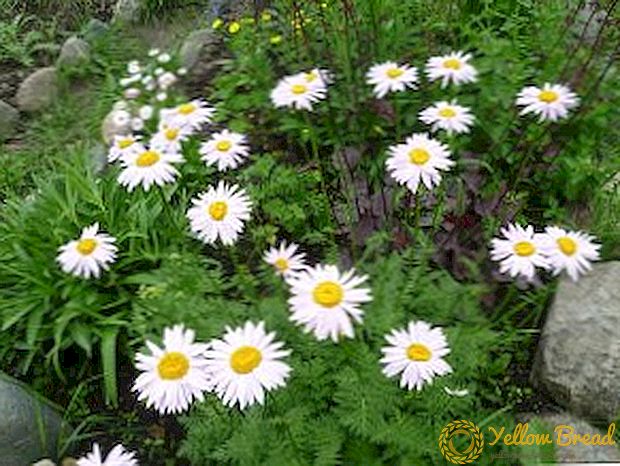 Pyrethrum - perennial. However, over time, the bush of Dalmatian chamomile begins to grow strongly, and the reverse process begins with flowering: the flowers become small, and eventually disappear altogether. Therefore, regardless of the desire to propagate pyrethrum, at least once every 3-4 years, the bushes must be divided for the purpose of rejuvenation. Simultaneously with such a division, it is recommended to transplant pyrethrum to a new location about once every five years, this is also necessary so that the flowering remains abundant.
Pyrethrum - perennial. However, over time, the bush of Dalmatian chamomile begins to grow strongly, and the reverse process begins with flowering: the flowers become small, and eventually disappear altogether. Therefore, regardless of the desire to propagate pyrethrum, at least once every 3-4 years, the bushes must be divided for the purpose of rejuvenation. Simultaneously with such a division, it is recommended to transplant pyrethrum to a new location about once every five years, this is also necessary so that the flowering remains abundant.
The procedure is carried out as soon as the plant has faded. The bush must be carefully dug, brushed off the ground (some even recommend rinsing the roots) and divided into several parts so that each part has an outlet. Such parts are seated separately and cared for as well as for an adult pyrethrum.Alternatively, feverfew can be propagated by dividing the rhizome, this is done in the spring in the process of digging up the site.
How to care for feverfew
Pyrethrum does not require special care, it is even called a plant for the lazy. The only exception is that weed control is necessary until the young plant has matured. In the same period, feverfew especially needs regular watering. It is not necessary to weed an adult Dalmatian chamomile; it successfully solves the problem of weed suppression.
Watering and mulching the soil
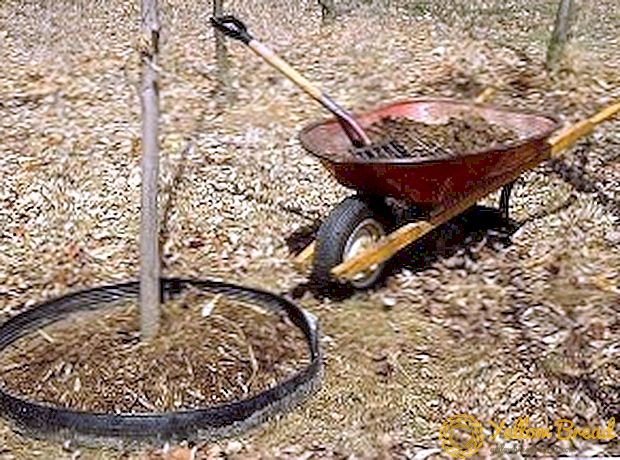 Formed pyrethrum does not need to be watered often. Soil moistening is necessary only in conditions of too hot summer and a long absence of precipitation (the soil should not crack and dry). Drought does not threaten the death of pyrethrum, just because of a lack of moisture, the flowers become smaller and less bright. The reverse state, which is really dangerous for feverfew, is waterlogging. After watering, the soil needs to be a little fluff to ensure oxygen access to the root system, as well as to retain moisture in the soil. Pyrethrum mulching is used, but is not mandatory, because, as has been said, neither the weeds, nor the lack of moisture (the main causes of mulching) the plant usually does not suffer.
Formed pyrethrum does not need to be watered often. Soil moistening is necessary only in conditions of too hot summer and a long absence of precipitation (the soil should not crack and dry). Drought does not threaten the death of pyrethrum, just because of a lack of moisture, the flowers become smaller and less bright. The reverse state, which is really dangerous for feverfew, is waterlogging. After watering, the soil needs to be a little fluff to ensure oxygen access to the root system, as well as to retain moisture in the soil. Pyrethrum mulching is used, but is not mandatory, because, as has been said, neither the weeds, nor the lack of moisture (the main causes of mulching) the plant usually does not suffer.
On the other hand, mulching is a necessary measure for preparing a perennial pyrethrum for winter. After pruning dry stems, the Dalmatian chamomile should be covered with hay, fallen leaves, and if winters are too severe, with spruce or pine branches. Practice shows that as a result of such procedures, from half to 90% of plants survive even after very severe frosts.
Top dressing feverfew
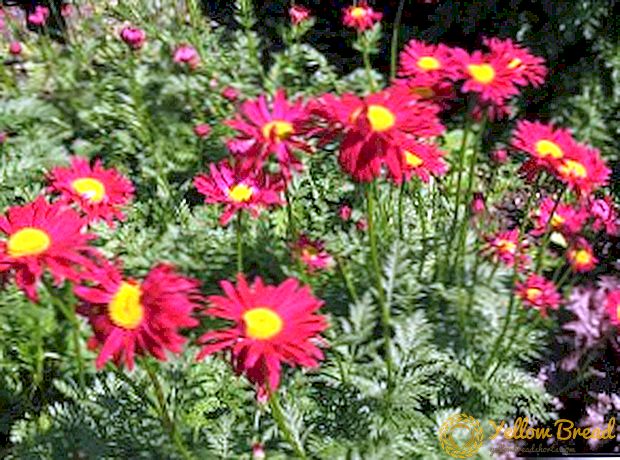 The main fertilizer, to which feverfew responds best, is rotted manure. To ensure good flowering it should be made in the form of mulching in the spring, in the fall during digging, and also as needed during the season. If the plant does not develop too actively, you can feed it by adding an infusion of mullein and complex mineral fertilizer (phosphorus, nitrogen and potassium in the ratio 2: 1: 1) to the irrigation water. Too poor soil can be composted.
The main fertilizer, to which feverfew responds best, is rotted manure. To ensure good flowering it should be made in the form of mulching in the spring, in the fall during digging, and also as needed during the season. If the plant does not develop too actively, you can feed it by adding an infusion of mullein and complex mineral fertilizer (phosphorus, nitrogen and potassium in the ratio 2: 1: 1) to the irrigation water. Too poor soil can be composted.
Pruning
Pruning feverfew carried out twice during the season: after the first flowering and before winter. Pruning peduncles after flowering has three goals: firstly, it prevents the uncontrolled process of self-seeding; secondly, provides re-bloom during the same season; thirdly, the dried flowers with which the plant is covered, look simply not aesthetically pleasing.Haircut, among other things, makes the bush more lush, provoking the formation of new shoots. Before winter, it is necessary to cut the buds, flower stalks and pyrethrum shoots, then cover the plant to help it withstand the winter frosts.
Partners, use in landscape design
 Pyrethrum combines perfectly with many plants, it all depends on where the Dalmatian chamomile is planted. In sunny areas, the bush can be placed next to the mysterious felicia, touching chamomile (garden or any other species of it), bright yellow doronicum, orange marigolds and marigolds. All these plants are similar to each other in the form of flowers, but have different and very bright shades, which creates the effect of a delightful flower bed in country style.
Pyrethrum combines perfectly with many plants, it all depends on where the Dalmatian chamomile is planted. In sunny areas, the bush can be placed next to the mysterious felicia, touching chamomile (garden or any other species of it), bright yellow doronicum, orange marigolds and marigolds. All these plants are similar to each other in the form of flowers, but have different and very bright shades, which creates the effect of a delightful flower bed in country style.
If the feverfew is planted in the shade, bells and blue-blue larkspur will look good next to. Dalmatian chamomile looks great, shrouded in thickets of cineraria. In general, the use of pyrethrum in landscape design is a topic for a separate article. Dalmatian chamomile is often planted around the perimeter of flower gardens (some gardeners even cut the plant so that it does not bloom, using only the green mass of pyrethrum for decorative purposes).
Also feverfew is planted along the curbs and paths. The formation on the basis of or with the participation of Dalmatian chamomile bright flower beds has already been mentioned above. Pyrethrum, planted under trees or near ornamental shrubs, looks good.
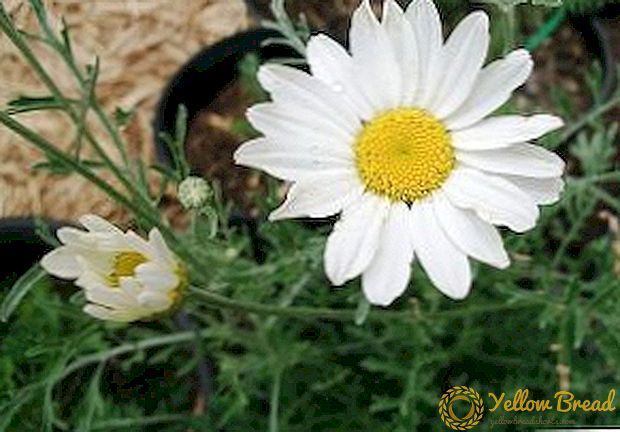 You can decorate with this bright chamomile arbor, veranda, terrace or balcony. Finally, feverfew for a long time can keep fresh in the form of cut flowers placed in vases. Due to its simplicity, varied shades and excellent compatibility with a variety of styles of landscape design, ferethrum is used with great pleasure by gardeners.
You can decorate with this bright chamomile arbor, veranda, terrace or balcony. Finally, feverfew for a long time can keep fresh in the form of cut flowers placed in vases. Due to its simplicity, varied shades and excellent compatibility with a variety of styles of landscape design, ferethrum is used with great pleasure by gardeners.
Diseases and pests, how to deal with them
Dalmatian chamomile, as a rule, is not exposed to pests and diseases, and this is the main surprising property of feverfew.
Sometimes feverfew can still affect black aphids. It can be fought with abundant washing of insects from the plant (special attention should be paid to the back of the leaves, this is where the pest lives), spraying the bushes with soap and water, decoctions of wormwood, tobacco and many other plants that the aphid does not tolerate. no time, you can simply buy any insecticide in a specialized store.
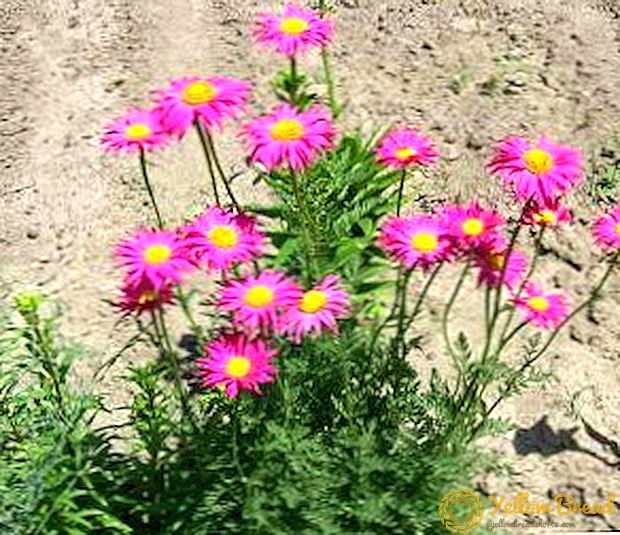 Pyrethrum girl can hit slugs. They are visible to the naked eye, in addition, their presence is indicated by characteristic lesions on the leaves of chamomile. In addition to the use of insecticides, against the slugs, you can use their natural enemies - birds and hedgehogs. There are many delicacies with which these animals can be attracted to the site. Gray rot - This is a fungal disease, an effective way to combat which does not exist: unfortunately, the affected plant must be removed and burned. Thrips - dangerous enemies of many garden flowers - feverfew does not affect, on the contrary, with the help of feverfew powder you can get rid of these nasty insects on other plants.Also, feverfew is used to treat fusarium (an unpleasant fungal disease that primarily affects the roots of plants).
Pyrethrum girl can hit slugs. They are visible to the naked eye, in addition, their presence is indicated by characteristic lesions on the leaves of chamomile. In addition to the use of insecticides, against the slugs, you can use their natural enemies - birds and hedgehogs. There are many delicacies with which these animals can be attracted to the site. Gray rot - This is a fungal disease, an effective way to combat which does not exist: unfortunately, the affected plant must be removed and burned. Thrips - dangerous enemies of many garden flowers - feverfew does not affect, on the contrary, with the help of feverfew powder you can get rid of these nasty insects on other plants.Also, feverfew is used to treat fusarium (an unpleasant fungal disease that primarily affects the roots of plants).
With the help of pyrethrum protect trees, shrubs, strawberries. An infusion made from its stems is able to kill flies, weevils, ticks, moths, ants, and the poison acts on both adults and their larvae (caterpillars) 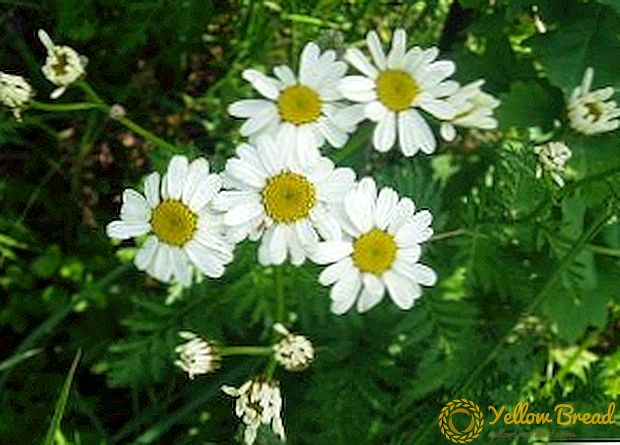 Thus, feverfew is one of the most unique garden flowers, combining amazing unpretentiousness, an extraordinary variety of shades and excellent ability to combine with various styles of landscape design, and also, as an additional bonus, the ability to scare away the most dangerous pests from fruit, vegetable and decorative crops.
Thus, feverfew is one of the most unique garden flowers, combining amazing unpretentiousness, an extraordinary variety of shades and excellent ability to combine with various styles of landscape design, and also, as an additional bonus, the ability to scare away the most dangerous pests from fruit, vegetable and decorative crops.



